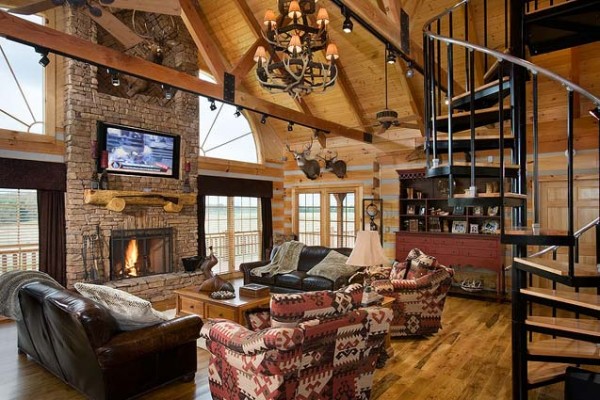Looking to design a great room that's open but livable? Check out these three fundamental great room design tips and you'll be on your way to log home greatness.

The key to successful great room design is to create intimate comfort zones within the volume of the space.
Great room design is one of the biggest challenges in a log home. Modern great rooms evolved when the barriers between kitchen, dining and living rooms were taken down. As these activity areas opened up so that everyone could be part of the action, the size of this room and the ceiling height increased significantly. Unfortunately, we often found ourselves with rooms that were simply too large for human comfort. So how do we celebrate the beauty of logs overhead and still create
a place that feels homey? How do we create the intimacy and comfort we seek? Read on for answers.
Comfort Zones
People feel more comfortable in rooms that are in proportion to our own dimensions. For this reason, alcoves, window seats, nooks, corners and areas with lowered ceilings appeal to us. Now think about a
great room with a cathedral ceiling. We're drawn to its height because it highlights the timbers and trusses. If the height makes the horizontal dimensions of the great room seem smaller, overall size of the room may need to increase to get the proper proportion. On the other hand, if you lower the ceiling, you can keep the room smaller and more intimate and you'll also bring the logs into better view.
Subspaces
As any room grows in size, it becomes necessary to divide it into subspaces. This can be done formally with posts, half-walls or changes in floor level, or informally with strategically placed area rugs and furniture groupings. The key to making a great room design work is to realize that we spend most of our time taking part in more intimate activities rather than in big gatherings. A large formal seating area consisting of a couple of couches can be placed in the center of the room, facing the fireplace. Near the windows, comfortable chairs surrounded by plants take in the view. A nook for reading occupies one corner, a piano the other.
Architectural Division
The
shape of the floor plan is another consideration. If the great room is set at an angle to other living spaces, the focus moves to the interesting views and spatial relationships and tones down the vertical dimension of high ceilings. Adding a bay or jogs in the walls can give the room variety and balance. Again, alcoves, window seats and special recesses for furniture or built-in cabinetry also help. Remember to look at relationships between rooms, too. For instance, the resident chef may want to talk with others while preparing a meal, but diners won't want to look into a messy kitchen while eating. To solve that problem, create visual breaks in your great room design, such as strategically placed posts, raised-bar counters, interceding cabinetry or a change in floor level. Changes in ceiling height also help. Making one area more intimate while maintaining visual access to another area adds definition and variety. Grouped beams and trusses in a great room create a pattern and rhythm overhead, influencing the room’s character.
 The key to successful great room design is to create intimate comfort zones within the volume of the space.
The key to successful great room design is to create intimate comfort zones within the volume of the space.











